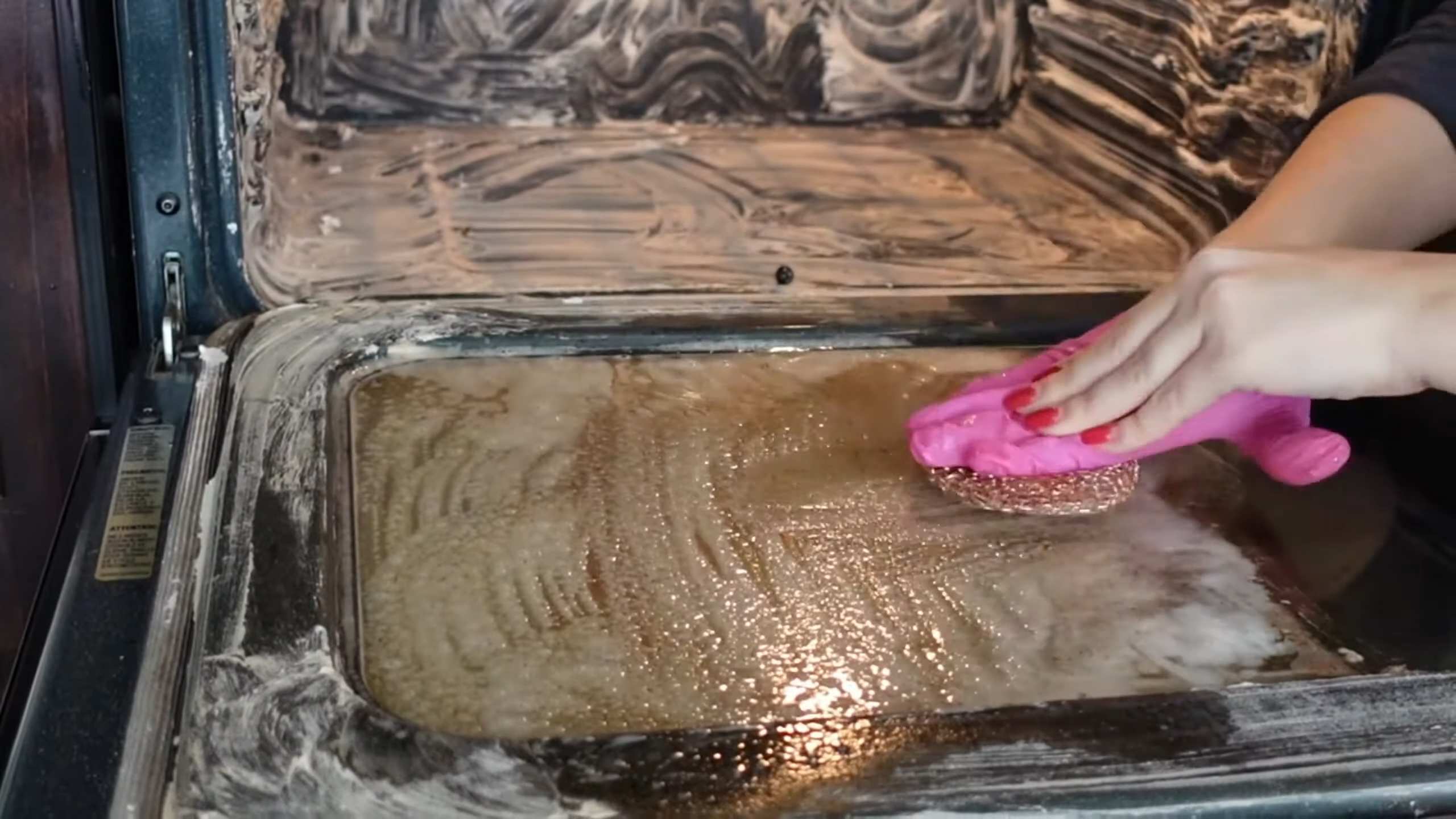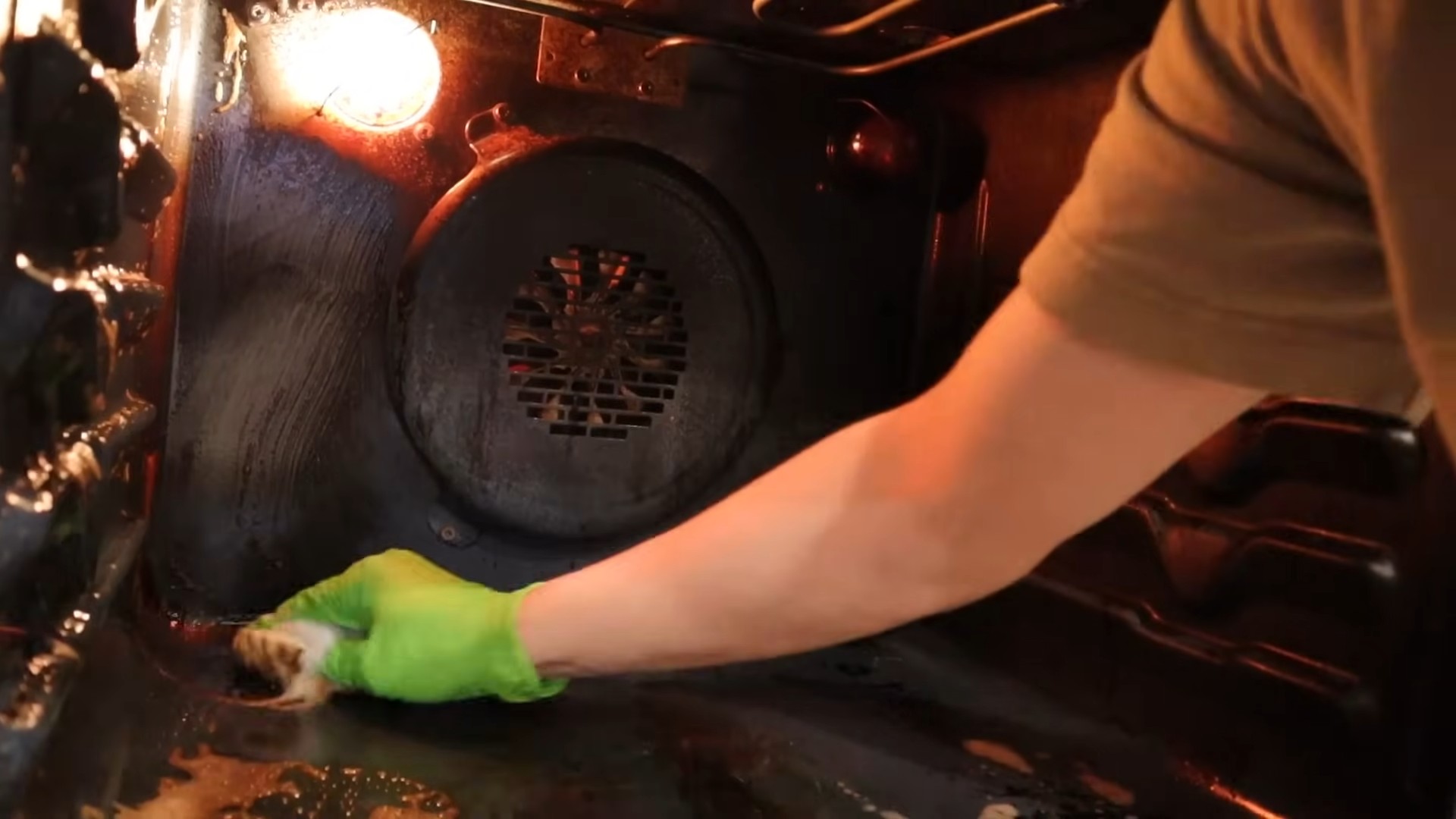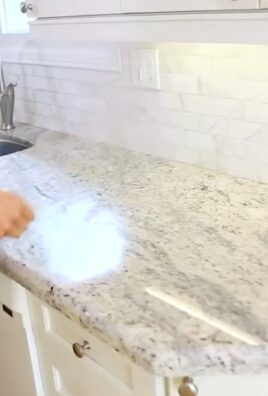Clean oven naturally – sounds like a dream, right? I know, the thought of tackling that greasy, burnt-on mess inside your oven can be daunting. But what if I told you that you could achieve a sparkling clean oven without harsh chemicals or expensive cleaning products?
For generations, resourceful homemakers have relied on natural ingredients to keep their homes clean and fresh. Before the advent of commercial oven cleaners, baking soda and vinegar were the go-to solutions for tackling tough kitchen messes. This tradition of using natural remedies is not only effective but also eco-friendly and safe for your family.
Let’s face it, nobody enjoys breathing in the fumes of chemical oven cleaners. They can be irritating to the skin, eyes, and respiratory system. Plus, many of us are becoming increasingly aware of the environmental impact of these products. That’s why learning how to clean oven naturally is so important. It’s a healthier, safer, and more sustainable way to maintain a clean and functional kitchen. In this article, I’m going to share my favorite DIY tricks and hacks for achieving a spotless oven using simple ingredients you probably already have in your pantry. Get ready to say goodbye to harsh chemicals and hello to a sparkling clean oven, naturally!

DIY Oven Cleaning: A Natural and Effective Guide
Hey there, fellow DIY enthusiasts! Are you staring down the barrel of a grimy, greasy oven and dreading the thought of harsh chemicals? I feel you! I used to reach for those strong-smelling cleaners too, but then I discovered a natural way to get my oven sparkling clean, and I haven’t looked back since. This method uses ingredients you probably already have in your pantry, and it’s much gentler on your lungs and the environment. Let’s get started!
What You’ll Need:
Before we dive in, let’s gather our supplies. This is a pretty straightforward process, so the list is short and sweet:
* Baking soda
* White vinegar
* Water
* Spray bottle
* Spatula or scraper (plastic is best to avoid scratching)
* Sponge or scrubbing brush
* Rubber gloves (optional, but recommended)
* Old towels or rags
Step-by-Step Oven Cleaning Process
Okay, now for the fun part! Follow these steps, and you’ll have a clean oven in no time.
1. Prepare the Oven: First things first, make sure your oven is completely cool. Safety first! Remove the oven racks, pizza stone, or anything else that’s inside. I usually soak my racks in hot, soapy water while I’m cleaning the oven itself. This helps loosen any baked-on gunk.
2. Create the Baking Soda Paste: In a bowl, mix together 1/2 cup of baking soda with a few tablespoons of water. Add water gradually until you form a spreadable paste. The consistency should be similar to frosting. If it’s too runny, add more baking soda. If it’s too thick, add a little more water.
3. Apply the Baking Soda Paste: Now, put on your gloves (if you’re using them) and generously spread the baking soda paste all over the inside of your oven. This includes the walls, floor, door (avoiding the heating elements), and even the glass window. I find it easiest to use my hands for this, but you can also use a spatula or a brush. Make sure to avoid the heating elements!
4. Let it Sit Overnight (or Longer): This is the most important step! The baking soda needs time to work its magic and loosen all that baked-on grime. I usually leave the paste on overnight, but if your oven is particularly dirty, you can leave it on for up to 24 hours. The longer it sits, the easier it will be to clean.
5. Scrub and Scrape: After the baking soda has had its time to work, grab your spatula or scraper and start scraping away the dried paste. You’ll be surprised at how much gunk comes off with it! Use a sponge or scrubbing brush to tackle any stubborn spots. I sometimes use an old toothbrush for those hard-to-reach corners.
6. Vinegar Power: Once you’ve removed as much of the baking soda paste as possible, it’s time for the vinegar. Pour some white vinegar into a spray bottle. Lightly spray the inside of the oven with vinegar. The vinegar will react with any remaining baking soda, creating a fizzing action. This helps to loosen any remaining grime.
7. Wipe it Down: After the vinegar has fizzed for a few minutes, use a damp sponge or rag to wipe down the entire inside of the oven. Rinse the sponge frequently to remove all the baking soda and vinegar residue. You may need to wipe it down several times to get it completely clean.
8. Clean the Oven Door: Don’t forget the oven door! If the glass is particularly dirty, you can use the baking soda paste on it as well. Let it sit for a few minutes, then scrub and wipe clean. For stubborn spots, you can also try using a razor blade scraper (be very careful not to scratch the glass!).
9. Replace the Racks: Once the oven is clean and dry, replace the oven racks. If you soaked them earlier, give them a good scrub and rinse before putting them back in.
10. Final Wipe Down: Give the entire oven one last wipe down with a clean, damp cloth to remove any lingering residue.
11. Turn on the Oven: Before you start cooking, turn on the oven to a low temperature (around 200°F or 93°C) for about 15-20 minutes. This will help to dry out any remaining moisture and eliminate any lingering odors. Keep an eye on it, and if you smell any vinegar, let it air out a bit longer.
Cleaning Heavily Soiled Oven Racks
Oven racks can be a real pain to clean, especially if they’re covered in baked-on grease. Here’s how I tackle them:
1. Soak the Racks: Fill your bathtub (or a large utility sink) with hot, soapy water. Add about 1/2 cup of dish soap and 1/2 cup of laundry detergent. Submerge the oven racks in the water and let them soak for at least 2 hours, or even overnight.
2. Scrub, Scrub, Scrub: After soaking, use a scrubbing brush or steel wool to scrub the racks clean. The baked-on grease should be much easier to remove after soaking. For really stubborn spots, you can try using a paste of baking soda and water.
3. Rinse Thoroughly: Rinse the racks thoroughly with clean water to remove all the soap and detergent residue.
4. Dry Completely: Dry the racks completely before putting them back in the oven. You can use a towel or let them air dry.
Tips and Tricks for a Sparkling Clean Oven
Here are a few extra tips and tricks that I’ve learned over the years to make oven cleaning even easier:
* Clean Regularly: The best way to keep your oven clean is to clean it regularly. I try to give mine a quick cleaning every few months, or whenever I notice it’s starting to get dirty.
* Use Oven Liners: Oven liners can help to catch spills and splatters, making cleanup much easier. You can find disposable oven liners at most grocery stores.
* Don’t Forget the Broiler Pan: The broiler pan can also get pretty dirty. I usually clean mine at the same time I clean the oven. You can use the same baking soda paste to clean the broiler pan.
* Ventilation is Key: Even though this is a natural cleaning method, it’s still important to have good ventilation. Open a window or turn on the exhaust fan while you’re cleaning the oven.
* Stubborn Stains: For really stubborn stains, you can try making a paste of baking soda and hydrogen peroxide. Apply the paste to the stain and let it sit for a few minutes, then scrub and wipe clean.
* Lemon Power: Another natural cleaning trick is to place a bowl of water with lemon slices in the oven and bake it at 350°F (175°C) for about 30 minutes. The steam will help to loosen any baked-on grime.
* Prevention is Better Than Cure: Try to wipe up spills as soon as they happen to prevent them from baking onto the oven floor.
Dealing with Burnt Food Smells
Sometimes, even after cleaning, a lingering burnt food smell can persist. Here are a few ways to get rid of it:
1. Vinegar Solution: Place a bowl of white vinegar in the oven overnight. The vinegar will absorb the odors.
2. Baking Soda Absorption: Sprinkle baking soda on the oven floor and leave it overnight. Vacuum it up in the morning.
3. Coffee Grounds: Similar to baking soda, dry coffee grounds can absorb odors. Place a bowl of dry coffee grounds in the oven overnight.
4. Activated Charcoal: Activated charcoal is a powerful odor absorber. Place a few pieces of activated charcoal in the oven overnight.
5. Ventilation: Open the oven door and windows to air out the oven. You can also use a fan to circulate the air.
Safety First!
While this is a natural cleaning method, it’s still important to take some safety precautions:
* Always make sure the oven is completely cool before cleaning.
* Wear rubber gloves to protect your hands from the baking soda and vinegar.
* Avoid getting baking soda or vinegar in your eyes.
* If you’re using a razor blade scraper, be very careful not to cut yourself.
* Never mix baking soda and vinegar in a closed container, as this can create pressure and cause an explosion.
Why I Love This Method
I’ve been using this natural oven cleaning method for years, and I absolutely love it. It’s effective, affordable, and much safer than using harsh chemicals. Plus, it’s a great way to reduce your environmental impact. I hope you give it a try and see for yourself how well it

Conclusion
So, there you have it! Ditching the harsh chemicals and embracing this natural oven cleaning method is more than just a trend; it’s a game-changer for your kitchen and your well-being. We’ve walked you through a simple, effective, and eco-friendly way to clean oven naturally, leaving it sparkling and ready for your next culinary adventure.
But why is this DIY trick a must-try? Beyond the obvious benefits of avoiding toxic fumes and saving money, this method is incredibly gentle on your oven. Harsh chemical cleaners can sometimes damage the interior surfaces, leading to premature wear and tear. Baking soda and vinegar, on the other hand, are naturally abrasive enough to remove grime without causing harm. Plus, the satisfaction of knowing you’ve achieved a spotless oven using only natural ingredients is truly rewarding.
Think of the possibilities! You can customize this method to suit your specific needs. For particularly stubborn stains, create a thicker baking soda paste and let it sit overnight. If you prefer a citrusy scent, add a few drops of lemon or orange essential oil to your vinegar solution. You can even use this method to clean your oven racks – simply soak them in a tub of hot water with baking soda and vinegar.
This isn’t just about cleaning; it’s about creating a healthier and more sustainable home. It’s about making conscious choices that benefit both you and the environment. It’s about taking pride in a clean and well-maintained kitchen, ready to inspire your next delicious creation.
We wholeheartedly encourage you to give this natural oven cleaning method a try. You’ll be amazed at the results. And more importantly, we want to hear about your experience! Share your before-and-after photos, your tips and tricks, and any variations you’ve discovered in the comments below. Let’s build a community of eco-conscious cooks who are passionate about keeping their kitchens clean and healthy, naturally. Your insights could help others discover the power of this simple yet effective DIY solution. So, grab your baking soda, vinegar, and a little elbow grease, and get ready to transform your oven! We can’t wait to see your sparkling results!
Frequently Asked Questions (FAQ)
1. How often should I clean my oven using this natural method?
The frequency of cleaning depends on how often you use your oven and how much splattering occurs. For average use, cleaning your oven every 1-3 months is generally sufficient. If you frequently bake or roast, or if you notice a lot of grease buildup, you might want to clean it more often. A quick spot clean after particularly messy cooking sessions can also help prevent buildup and make future cleanings easier. Remember, regular maintenance is key to keeping your oven in top condition and preventing the need for harsh chemicals.
2. Can I use this method on a self-cleaning oven?
While this method is generally safe for most ovens, it’s always best to consult your oven’s manual before using any cleaning method, especially on a self-cleaning oven. Some self-cleaning ovens have specific coatings or features that could be damaged by baking soda or vinegar. If your manual advises against using these ingredients, it’s best to err on the side of caution. However, many people successfully use this method on self-cleaning ovens as a gentler alternative to the high-heat self-cleaning cycle. If you choose to try it, start with a small, inconspicuous area to test for any adverse reactions.
3. What if the baking soda paste is too difficult to remove?
If the baking soda paste has dried and become difficult to remove, don’t panic! Simply spray the area generously with vinegar and let it sit for a few minutes. The vinegar will react with the baking soda, loosening the paste and making it easier to wipe away. You can also use a plastic scraper or spatula to gently lift the paste. Avoid using metal scrapers, as they can scratch the oven’s interior. For particularly stubborn areas, you might need to repeat the process a few times. Patience is key!
4. Is it safe to use this method if I have pets or small children?
Yes, this natural oven cleaning method is generally considered safe for pets and small children, as it doesn’t involve harsh chemicals or toxic fumes. However, it’s always a good idea to keep them away from the area while you’re cleaning to prevent them from accidentally ingesting baking soda or vinegar. Ensure the oven is thoroughly rinsed and dried before allowing pets or children near it again. As with any cleaning product, keep baking soda and vinegar out of reach when not in use.
5. Can I use this method to clean the oven door glass?
Absolutely! This method works wonders on oven door glass. Simply apply the baking soda paste to the glass, let it sit for a while, and then wipe it away with vinegar and a damp cloth. For particularly stubborn stains, you can use a non-abrasive scrubbing pad. Be careful not to scratch the glass. You can also use a razor blade scraper *very carefully* at an angle to remove baked on debris. This method is much safer and more effective than using harsh chemical cleaners on the oven door glass.
6. What if I don’t have vinegar? Can I use something else?
While vinegar is the ideal ingredient for reacting with the baking soda and loosening grime, you can try using lemon juice as a substitute. Lemon juice is acidic and has natural cleaning properties. However, it may not be as effective as vinegar for removing tough stains. If you don’t have either vinegar or lemon juice, you can try using a solution of warm water and dish soap, but it may require more scrubbing.
7. How do I get rid of the vinegar smell after cleaning?
The vinegar smell should dissipate fairly quickly after cleaning. To speed up the process, you can leave the oven door open for a while to allow it to air out. You can also place a bowl of baking soda or coffee grounds inside the oven to absorb any lingering odors. Another option is to boil a pot of water with a few slices of lemon or orange peel. The steam will help to neutralize the vinegar smell and leave your kitchen smelling fresh and clean.
8. Can I use this method on a convection oven?
Yes, this method is generally safe to use on a convection oven. However, it’s important to avoid getting baking soda or vinegar into the convection fan or heating element. Be extra careful when cleaning around these areas. If you’re concerned, you can consult your oven’s manual for specific cleaning instructions.
9. What are some other natural cleaning tips for my kitchen?
Besides cleaning your oven naturally, there are many other ways to keep your kitchen clean and healthy using natural ingredients. You can use baking soda and water to clean countertops, sinks, and stovetops. Lemon juice is a great natural disinfectant and can be used to clean cutting boards and remove stains from plastic containers. White vinegar is a versatile cleaner that can be used to clean floors, windows, and appliances. By incorporating these natural cleaning tips into your routine, you can create a healthier and more sustainable kitchen environment.
10. My oven is really dirty. Will this method still work?
Yes, this method can still work on a very dirty oven, but it may require more time and effort. You might need to apply the baking soda paste multiple times and let it sit for longer periods. You may also need to use a non-abrasive scrubbing pad to remove stubborn stains. For extremely dirty ovens, you can try preheating the oven to a low temperature (around 200°F) for a few minutes to loosen the grime before applying the baking soda paste. Remember to turn off the oven and let it cool slightly before cleaning. With patience and persistence, you can achieve a sparkling clean oven, even if it’s heavily soiled.





Leave a Comment